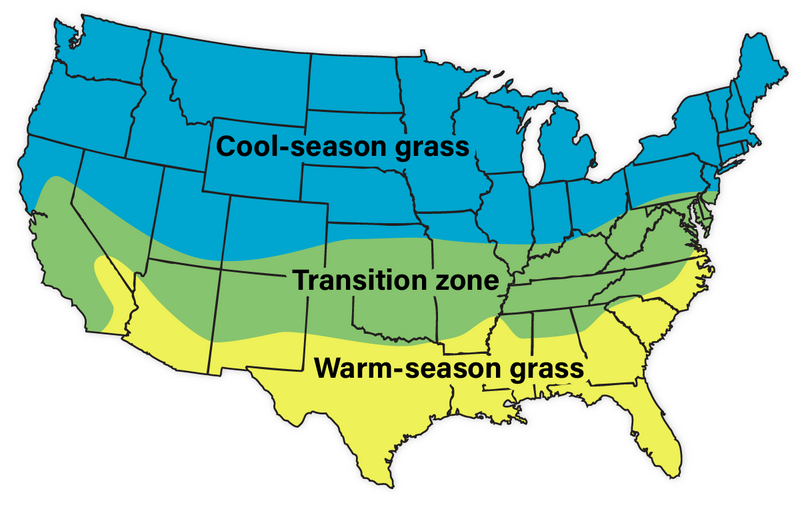
If you want to keep your grass in prime condition, mowing is one of the best ways to keep your grass healthy and strong. But how often should you mow for optimum health?
In this article, we’ll discuss how often to mow based on your type of grass and other factors that affect your mowing frequency.
Mowing by grass type
The first step in determining how often to mow is to know your grass type. Do you have warm-season grass or cool-season grass? Check this chart below to see the recommended cutting height for your grass type.
| Grass Name | Grass Type | Recommended Height for Home Lawns |
| Kentucky bluegrass | Cool Season | 2.5-3.5 inches |
| Perennial ryegrass | Cool Season | 1.5-2.5 inches |
| Creeping red fescues | Cool Season | 3-3.5 inches |
| Turf-Type Tall Fescue* | Cool Season | 2-3 inches |
| Common bermuda grass* | Warm Season | 1-2 inches |
| Hybrid bermuda* | Warm Season | 1-1 ½ inches |
| Centipede* | Warm Season | 1-2 inches |
| St. Augustine* | Warm Season | 2-3 inches |
| Zoysia* | Warm Season | 1-2 inches |
- * Add ½ inch to these ranges during the hottest part of the season.
You may see slight variations among publications as to how tall a species should be cut. If you are in doubt as to how tall your grass should be cut, contact a local Extension specialist.
Follow the one-third rule
The one-third rule is the best gauge for how often to mow your grass. It simply means that you should only take off one-third of the grass blade per mow. So, for example, if you cut your grass to 2 inches, wait until the grass reaches 3 inches to mow.
Cutting off more than one-third of the grass height may not seem like a big deal, but consider these fascinating facts about turf height and the health of your lawn:
✓ A taller leaf blade generally results in deeper roots
✓ A deeper root system may help with drought tolerance, stress management, and nutrient use
✓ A taller cut helps with weed control
So, next time you’re tempted to cut off an extra inch, resist, and your lawn will reap the benefits.
Other factors that affect mowing height
Time of year

During the height of the growing season, expect your mowing frequency to increase. Conversely, expect to mow less frequently during the shoulder seasons because your lawn is growing more slowly.
Two slow-growing types of grass are centipedegrass and Zoysiagrass. Other grasses have a medium to high mowing frequency, especially during the spring flush and in the fall for cool-season grasses. So, expect to mow more frequently during those times.
Pro Tip: For both warm- and cool-season grasses, cut the lawn slightly lower than the recommended mowing height on the final few cuts in fall and the first few cuts in spring. In between these times, follow the recommended mowing height for your grass type.
Turf use
Home lawns are less strenuous to maintain than professional turf. Athletic fields are mowed as often as once per day because they are mowed very short. Due to their short turf, they must be mowed more often so they don’t cut more than ⅓ of the grass blade at a time.
Basic lawn mowing tips
✓ Keep your mower blades sharp.
✓ If you have an overgrown lawn, start out mowing it at the highest setting on your lawnmower. Wait a few days and cut again a little lower. Repeat this process until you reach the optimal height for your grass type.
✓ Mulch the grass clippings back into the lawn as you mow for a nitrogen boost. Use a mulching lawn mower for the best results.
✓ Mow between 8-10 a.m. for best results.
✓ Don’t mow when the grass is wet.
A healthy lawn
As soon as you know what type of grass you have, you should be all set. Just remember to follow the one-third rule and follow our basic mowing tips to have healthy, properly cut grass throughout the growing year.
If you prefer to have your lawn maintenance chores outsourced to someone who knows the difference between bluegrass and bahiagrass, contact a lawn care professional to set up an ideal mowing schedule for your lawn.
Main Photo Credit: congerdesign | Pixabay